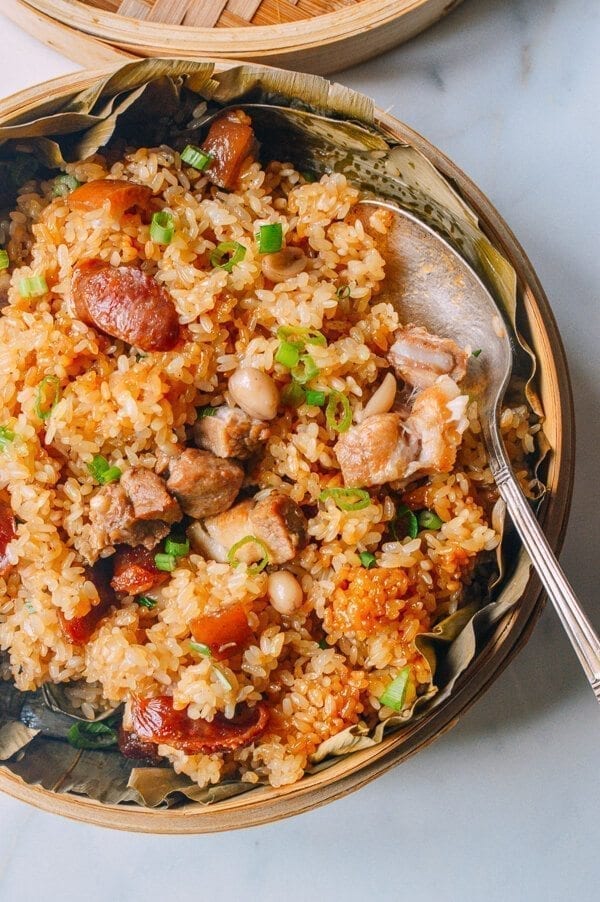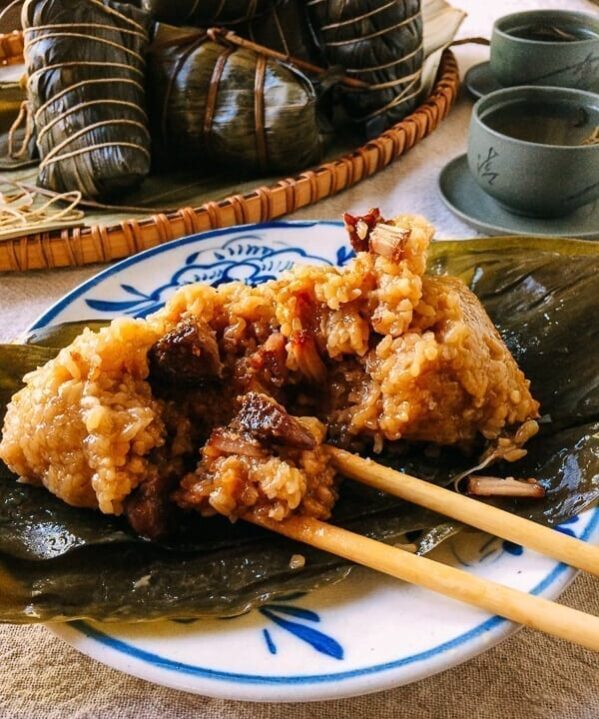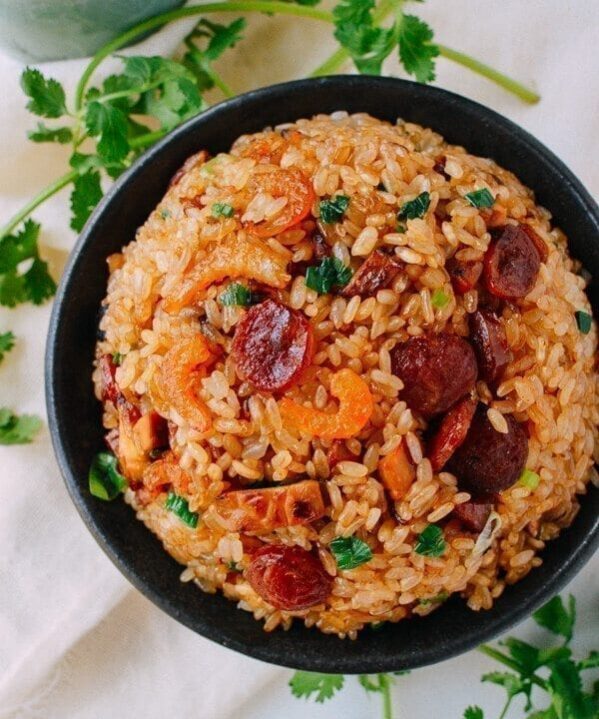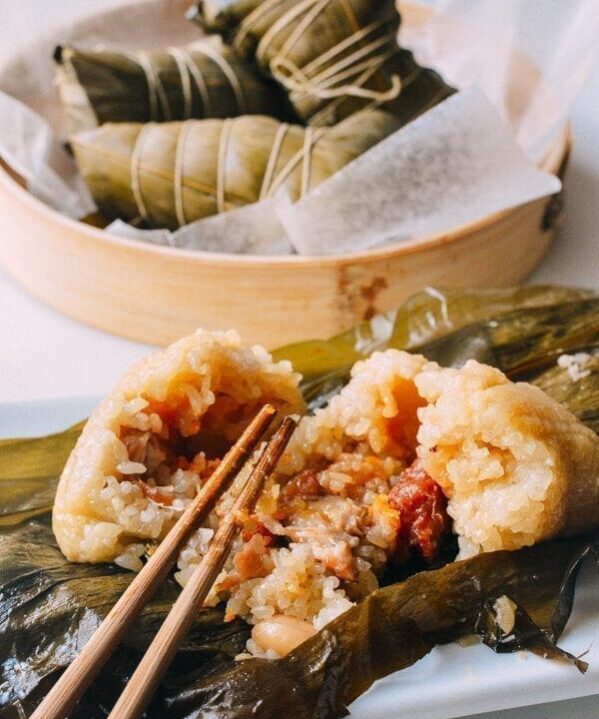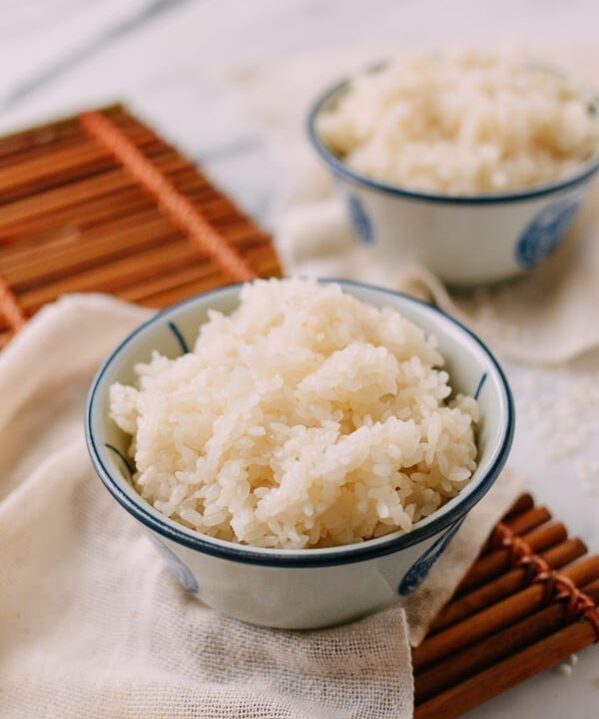The Dragon Boat Festival (Duānwǔ jié) is nearly here (June 25th), and you know what that means? Zongzi. (Or joong in Cantonese.) Tasty wrapped sticky rice dumplings with assorted fillings, steamed to perfection.
This version, however, is a shortcut to zongzi flavors, without the work of forming them into individual dumplings. If you love eating zongzi, but you’re over the whole “wrap them in a leaf” thing, this recipe is for you!
Sometimes Shortcuts Are OK.
We’re here to say that sometimes, a shortcuts are allowed. Okay, even!
We’re no strangers to the hard work and love that go into traditional sticky rice dumplings/zongzi. We’ve posted several zongzi recipes over the years, including our Cantonese-style Zongzi with Pork, Chinese Sausage, Peanuts, and Duck Egg Yolk, Shanghai-Style Pork Zongzi, and Jianshui Zongzi with Red Bean.
Making zongzi can be quite the production. It takes two days and hours of wrapping (unless you have an army of experienced wrappers on your side!). We still believe they’re worth that time and effort.
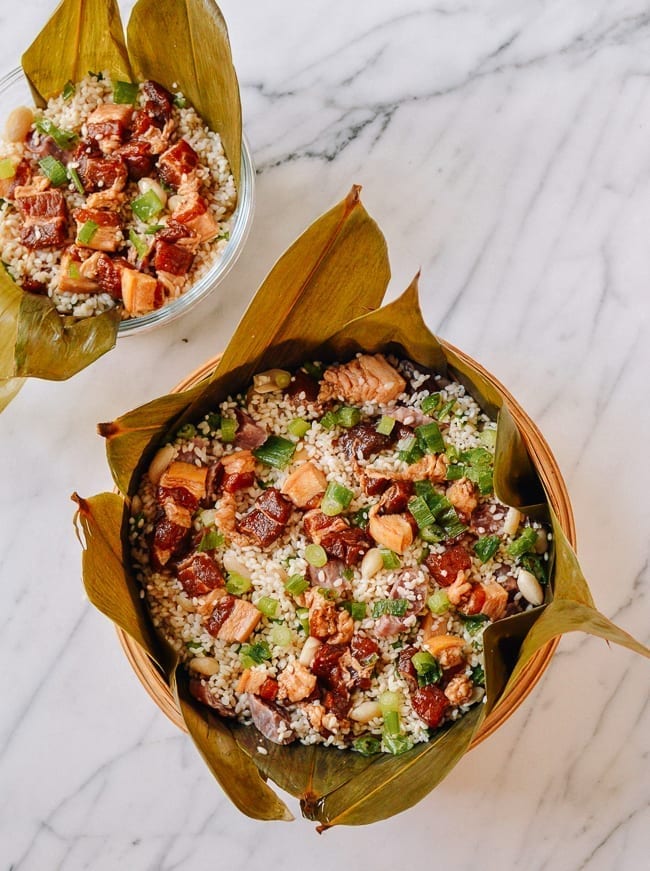
However, sometimes, we just don’t HAVE time on our side. This “Lazy Shortcut Zongzi” is for those who want to enjoy those nostalgic, delicious flavors this Dragon Boat Festival, without bothering with scissors, string, or cascading grains of sticky rice.
You simply line a bamboo steamer with soaked zongzi leaves, add seasoned rice and fillings, and steam for 60-90 minutes. It may not be traditional, but it is the lazy (or busy) cook’s way out.
You still get the flavor of the bamboo leaves in the rice. You still get delicious steamed filling. But you’ve cut down on the assembly time AND the cooking time (wrapped zongzi take 7-8 hours to cook).
Note, for those of you thinking––wait this recipe STILL takes 8 hours to prepare!? If you soak your ingredients ahead of time overnight, the actual assembly time takes only 30 minutes or so (as opposed to several hours). Also, the cook time will be about 60-90 minutes as opposed to 7 hours. Still a significant time savings!
If you DO want to wrap your zongzi in the traditional way, but want a faster way to cook them, check out our post on How to Cook Zongzi in an Instant Pot.
Which Version Did We Make?
This recipe is closest to our Cantonese-Style Zongzi (joong), with pork belly, peanuts, and Chinese sausage (we left out the duck egg yolks this time, but you can add them in if you like).
Note that Cantonese Zongzi are generally milder in flavor. You can jazz it up by adding 1 teaspoon of grated ginger to the pork belly marinade, and also add salted duck egg yolks or dried seafood (dried shrimp or dried scallops) to kick up the umami—just be sure to soak them beforehand for 2-6 hours.
You can also apply this method to our Shanghai-Style Pork Zongzi. The soy sauce flavor will be stronger, with a fully seasoned rice mixture. The meat should be marinated overnight.
We’d be a little more reluctant to use this method for the Jianshui Zongzi, because we’re purists when it comes to those (they’re like little pieces of art), but you could certainly try it!
Shortcut Chinese Zongzi: Recipe Instructions
Soak the uncooked sticky rice overnight (or at least 6 hours).
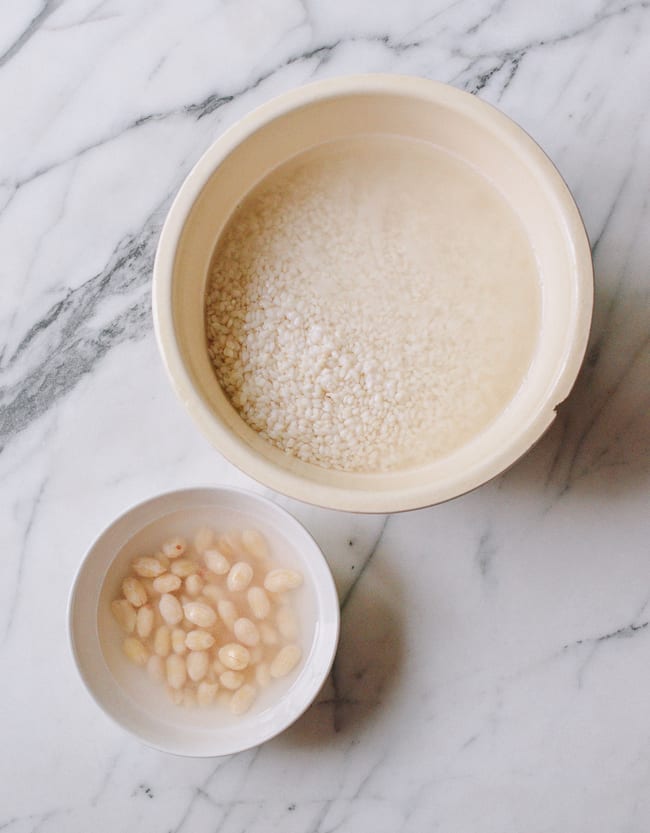
Soak the dried bamboo leaves for at least 3 hours (or overnight). After soaking, wash and rinse each leaf front and back, keeping them in a large bowl or tub of water so they don’t dry out.
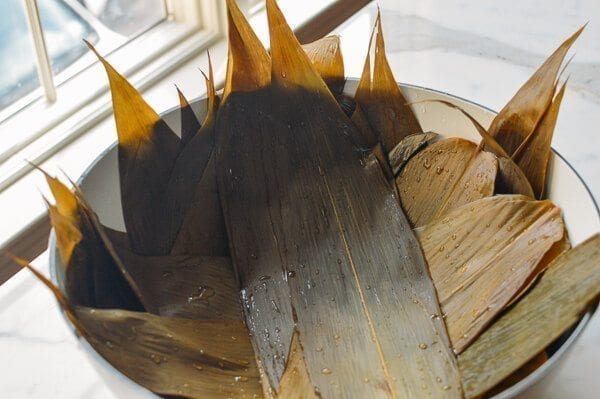
Cut the pork belly into ½ inch bite-sized pieces.
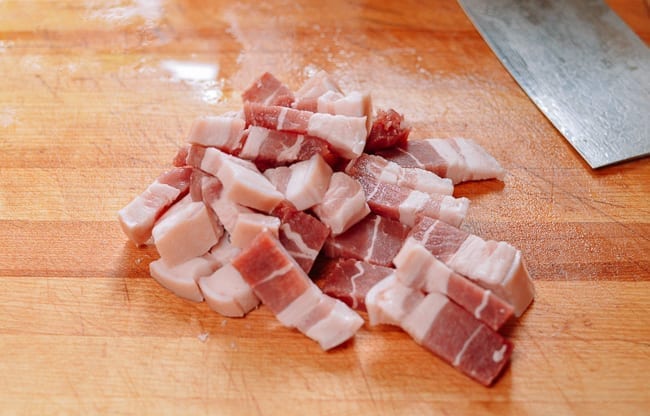
Marinate it with 1 tablespoon light soy sauce, 1/2 teaspoon salt, ½ teaspoon dark soy sauce, 1 tablespoon Shaoxing wine, 1/2 teaspoon sugar, and ½ teaspoon white pepper. Marinate for 1 – 2 hours in the refrigerator.
Drain the soaked sticky rice completely.
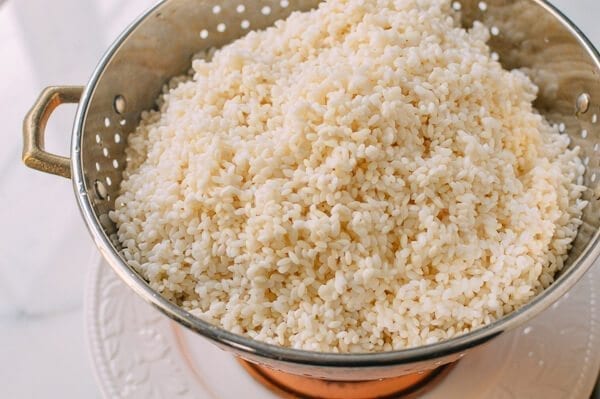
Mix the rice with 1 tablespoon light soy sauce and 1 teaspoon salt in a large bowl and set aside.
Soak the peanuts for 1 hour. Then boil for 10 minutes and drain.
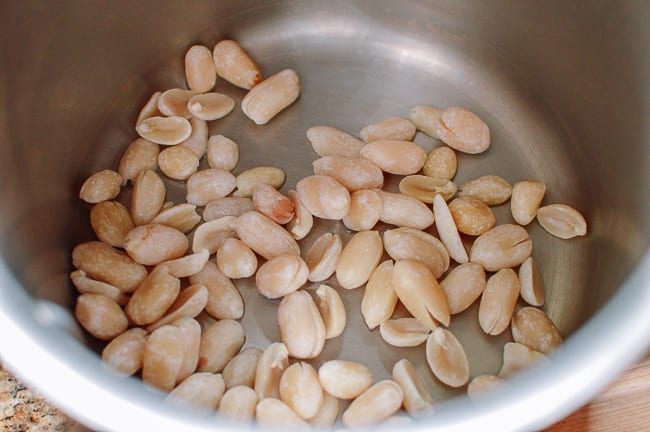
And add the peanuts to the rice along with the Chinese sausages and scallions. (If adding cooked salted duck egg yolks and/or soaked dried seafood, you can mix them into the rice as well).
Line a bamboo steamer (or large shallow heatproof bowl) with 6-7 bamboo leaves. These bamboo leaves will provide flavor to the rice as well as prevent it from sticking. All with a layer of rice mixture, a layer of pork belly, another layer of rice mixture, and a layer of pork belly on top. Make sure everything is evenly distributed (so it can cook evenly).
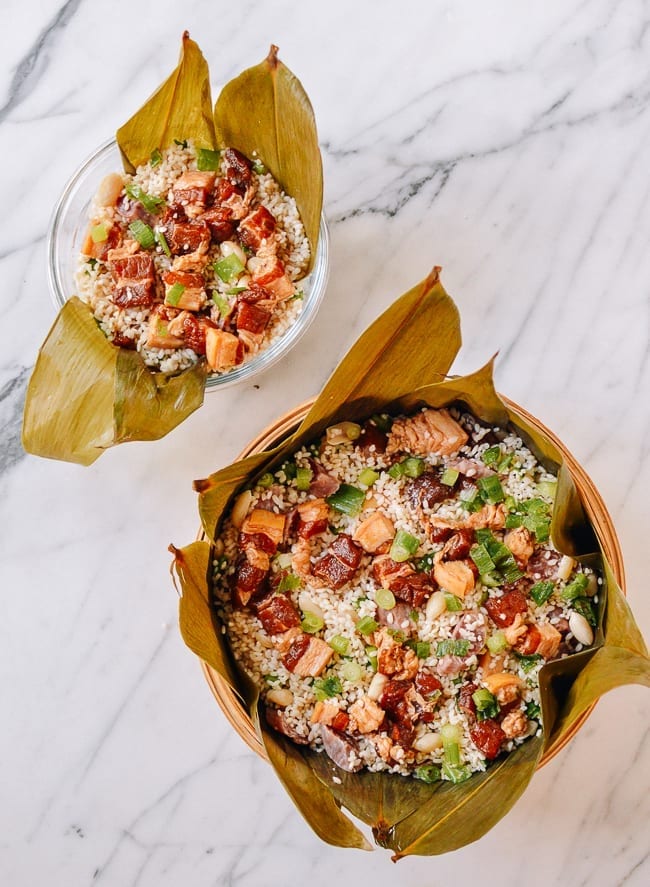
As you can see in the photo above, I made one batch in my bamboo steamer, but I also made a mini one in a heatproof glass container (with a lid), which I covered and froze for later. The freezing process will “break” the rice, since it was soaked in water (see my mom’s 20-Minute Congee Technique for more details). But it will save time, and the broken rice will also cook faster!
Cover the mixture with the remaining bamboo leaves to trap in moisture as well as the bamboo leaf aroma. If using a bamboo steamer, you can simply put on the cover.
If using a heatproof bowl to steam, you can use a toothpick to keep the bamboo leaves in place on top of the rice.
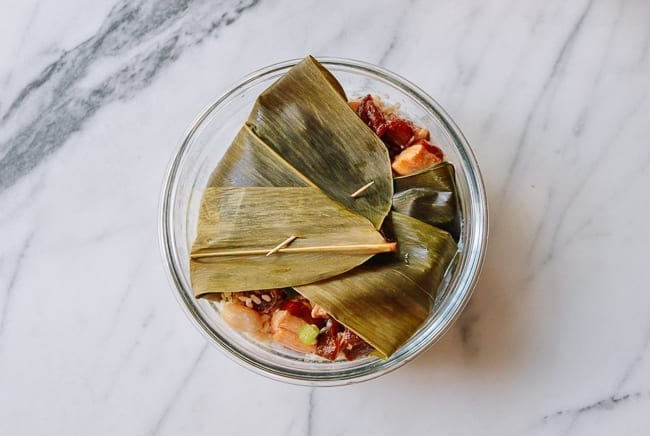
Place the rice in the steamer, starting with cold water. Turn on the heat to high, and once the water starts to boil, steam for 60-90 minutes. 1 hour will yield more al dente sticky rice, while will get you a slightly more tender texture.
Check periodically to make sure there is still water in the steamer, and add hot water if needed.
Note!
Using this shortcut method, the sticky rice won’t get as gooey as the rice in traditional zongzi, which are cooked in a pot with water, but it’s a trade-off when it comes to time savings here. You CAN try to achieve a slightly gooier texture by adding 1/2-3/4 cup water to the rice right before steaming.
Keep in the steamer on low heat until ready to serve. The rice will harden if cooled. Serve your shortcut version of traditional sticky rice dumplings hot!
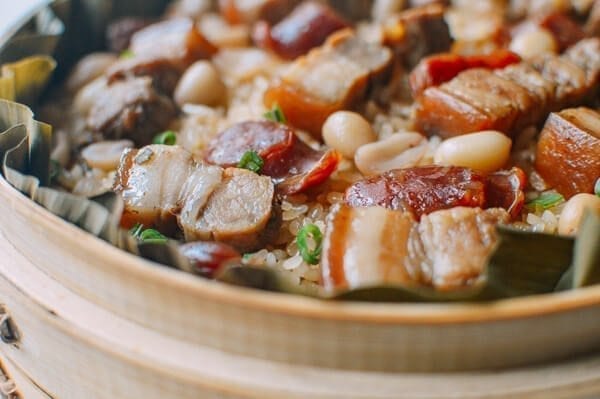
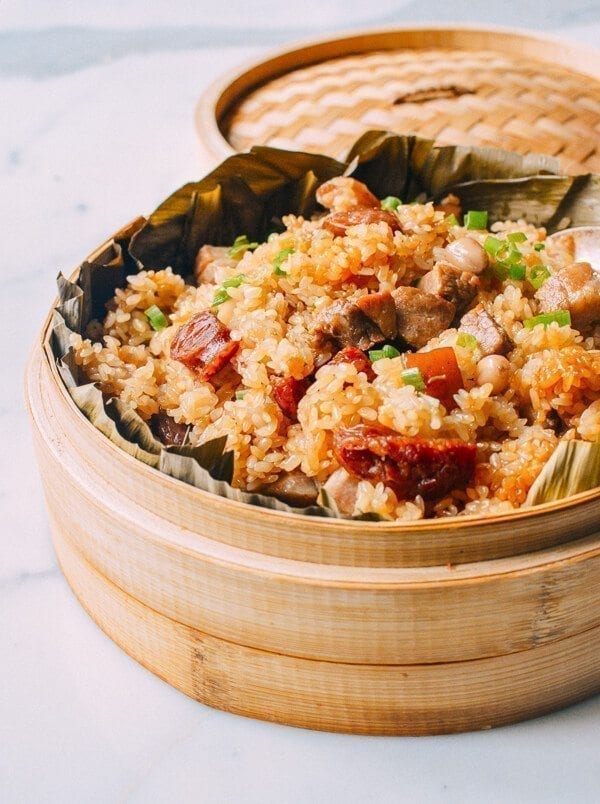
Shortcut Sticky Rice Dumplings (Zongzi)
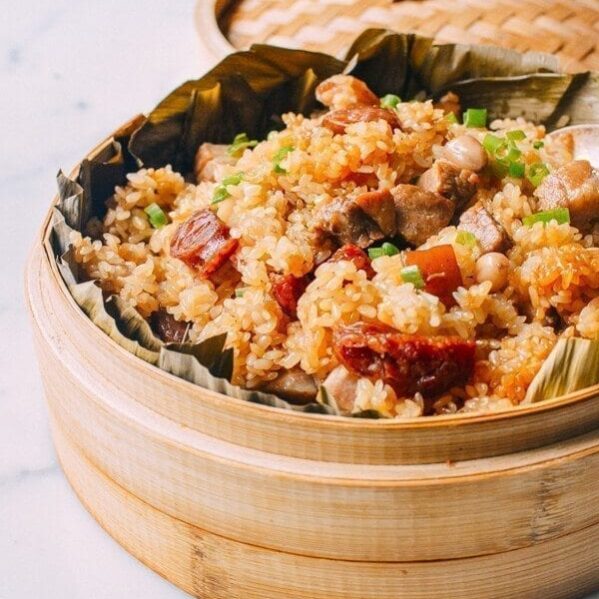
Ingredients
- 2 1/2 cups uncooked sticky rice (also called glutinous rice or "sweet rice")
- 8-10 dried bamboo leaves
- 1/2 pound pork belly
- 2 tablespoons light soy sauce (divided)
- 1/2 teaspoon salt (plus 1 teaspoon, divided)
- 1/2 teaspoon dark soy sauce
- 1 tablespoon Shaoxing wine
- 1/2 teaspoon sugar
- 1/2 teaspoon white pepper
- 1/2 cup raw shelled peanuts
- 2-3 Chinese sausages (lap cheung; cut into small chunks)
- 2-3 scallions (chopped)
Instructions
- Soak the uncooked sticky rice overnight (or at least 6 hours). Soak the dried bamboo leaves for at least 3 hours (or overnight). After soaking, wash and rinse each leaf front and back, keeping them in a large bowl or tub of water so they don’t dry out.
- Cut the pork belly into ½ inch bite-sized pieces, marinate it with 1 tablespoon light soy sauce, 1/2 teaspoon salt, ½ teaspoon dark soy sauce, 1 tablespoon Shaoxing wine, 1/2 teaspoon sugar, and ½ teaspoon white pepper. Marinate for 1 – 2 hours in the refrigerator.
- Soak the peanuts for 1 hour. Then boil for 10 minutes, drain, and set aside.
- Drain the soaked sticky rice completely. Mix the rice with 1 tablespoon light soy sauce and 1 teaspoon salt in a large bowl.
- Add the peanuts to the rice along with the Chinese sausages and scallions. (If adding cooked salted duck egg yolks and/or soaked dried seafood, you can mix them into the rice as well).
- Line a bamboo steamer (or large shallow heatproof bowl) with 6-7 bamboo leaves. These bamboo leaves will provide flavor to the rice as well as prevent it from sticking. All with a layer of rice mixture, a layer of pork belly, another layer of rice mixture, and a layer of pork belly on top. Make sure everything is evenly distributed (so it can cook evenly).
- Cover the mixture with the remaining bamboo leaves to trap in moisture as well as the bamboo leaf aroma. If using a bamboo steamer, you can simply put on the cover. If using a heatproof bowl to steam, you can use a toothpick to keep the bamboo leaves in place on top of the rice.
- Place the rice in the steamer, starting with cold water. Turn on the heat to high, and once the water starts to boil, steam for 60-90 minutes. Check periodically to make sure there is still water in the steamer, and add hot water if needed.
- Keep in the steamer on low heat until ready to serve. The rice will harden if cooled. Serve hot!
